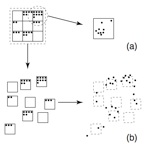Ubilab
Below is a list of selected publications that I have been working on at Ubilab, the IT research and technology transfer lab of UBS. Ubilab does not exist anymore, but the archive is still available.
Combining topological clustering and multidimensional scaling for visualizing large data sets

We present a new strategy for dimensionality reduction which address the performance issues created by large data sets. It relies on the self-organizing map algorithm to perform topological pre-clustering, and on a spring model to achieve metric multidimensional scaling. By taking advantage of the distinct properties of these two methods, we provide a framework which can flexibly balance between quality- and speed-on-demand. Our approach permits the exploration of large data sets and delivers an intuitive frame of reference to the user.
D. Brodbeck, L. Girardin. Combining topological clustering and multidimensional scaling for visualizing large data sets. IEEE Symposium on Information Visualization '98, Research Triangle Park, NC, October 19-20, 1998.
Domesticating Bead: Adapting an Information Visualization System to a Financial Institution

The Bead visualization system employs a fast algorithm for laying out high-dimensional data in a low-dimensional space, and a number of features added to 3D visualiza- tions to improve imageability. Here we describe recent work on both aspects of the system, in particular a gener- alization of the data types laid out and the implementation of imageability features in a 2D visualization tool. The variety of data analyzed in a financial institution such as UBS, and the ubiquity of spreadsheets as a medium for analysis, led us to extend our layout tools to handle data in a generic spreadsheet format. We describe the metrics of similarity used for this data type, and give examples of layouts of sets of records of financial trades. Conservatism and scepticism with regard to 3D visualization, along with the lack of functionality of widely available 3D web browsers, led to the development of a 2D visualization tool with refinements of a number of our imageability features.
D. Brodbeck, M. Chalmers, A. Lunzer, P. Cotture. Domesticating Bead: Adapting an Information Visualization System to a Financial Institution. In John Dill, Nahum Gershon (editors), Proceedings of Information Visualization '97, Phoenix, AZ, October 20-21 1997, pp. 73-80.
The Order of Things: Activity-Centred Information Access

This paper focuses on the representation and access of Web-based information, and how to make such a representation adapt to the activities or interests of individuals within a community of users. The heterogeneous mix of information on the Web restricts the coverage of traditional indexing techniques and so limits the power of search engines. In contrast to traditional methods, and in a way that extends collaborative filtering approaches, the path model centres representation on usage histories rather than content analysis. By putting activity at the centre of representation and not the periphery, the path model concentrates on the reader not the author and the browser not the site. We describe metrics of similarity based on the path model, and their application in a URL recommender tool and in visualising sets of URLs.
M. Chalmers, K. Rodden D. Brodbeck. The order of things: activity-centred information access. In Proc. 7th Intl. World Wide Web Conference, Brisbane, Australia, April 1997, pp. 359-368.




© 2010 Dominique Brodbeck